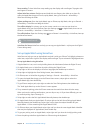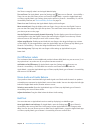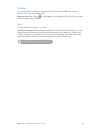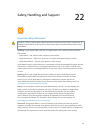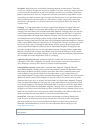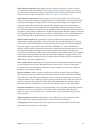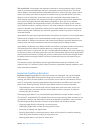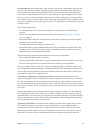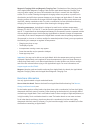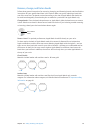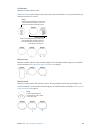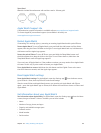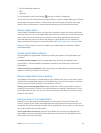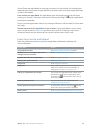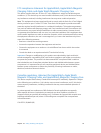Chapter 22 Safety, Handling, and Support 85
Cleaning and care Keep Apple Watch clean and dry. Clean and dry Apple Watch, the band, and
your skin after workouts or heavy sweating. Dry Apple Watch and the band thoroughly if they
are exposed to fresh water. Clean Apple Watch if it comes in contact with anything that may
cause stains, or other damage, such as dirt or sand, makeup, ink, soap, detergent, acids or acidic
foods, or comes in contact with liquids other than fresh water, including those that may lead to
skin irritation such as: sweat, salt water, soapy water, pool water, perfume, insect repellent, lotions,
sunscreen, oil, adhesive remover, hair dye, or solvents. The Apple Watch and band colors may vary
or fade over time.
How to clean Apple Watch:
•
Turn o Apple Watch. Press and hold the side button, then drag the Power O slider to
the right.
•
Depress the band release buttons and remove the band. See Remove, change, and fasten
bands on page 87.
•
Wipe Apple Watch clean with a nonabrasive, lint-free cloth. If necessary, you can also lightly
dampen the cloth with fresh water.
•
Dry Apple Watch with a nonabrasive, lint-free cloth.
•
Apple Watch Edition (gold) models benet the most if you clean them regularly. Clean with
a nonabrasive, lint-free cloth to remove surface oil, perfumes, lotions, and other substances,
especially before storing Apple Watch Edition.
The following things are not recommended in the care of your Apple Watch:
•
Don’t clean Apple Watch while it’s charging.
•
Don’t dry Apple Watch or the bands using any external heat source (for example, a hair dryer).
•
Don’t use cleaning products or compressed air when cleaning your Apple Watch.
The front of Apple Watch is made of Ion-X glass (strengthened glass) or sapphire crystal, each
with a ngerprint-resistant oleophobic (oil repellent) coating. This coating wears over time with
normal usage. Cleaning products and abrasive materials will further diminish the coating, and
may scratch the glass or the sapphire crystal.
Using buttons, Digital Crown, connectors, and ports Never apply excessive pressure to a
button or the Digital Crown on Apple Watch, or force a charging connector into a port, because
this may cause damage that is not covered under the warranty. If the connector and port don’t
join with reasonable ease, they probably don’t match. Check for obstructions and make sure that
the connector matches the port and that you have positioned the connector correctly in relation
to the port.
Certain usage patterns can contribute to the fraying or breaking of cables. The cable attached
to a charging unit, like any other metal wire or cable, is subject to becoming weak or brittle if
repeatedly bent in the same spot. Aim for gentle curves instead of angles in the cable. Regularly
inspect the cable and connector for any kinks, breaks, bends, or other damage. Should you nd
any such damage, discontinue use of the cable.
Lightning to USB Cable Discoloration of the Lightning connector after regular use is normal.
Dirt, debris, and exposure to moisture may cause discoloration. If your Lightning cable or
connector become warm during use or if Apple Watch won’t charge or sync, disconnect the
cable from the power adapter and clean the Lightning connector with a nonabrasive, dry, lint-
free cloth. Do not use liquids or cleaning products when cleaning the Lightning connector.



